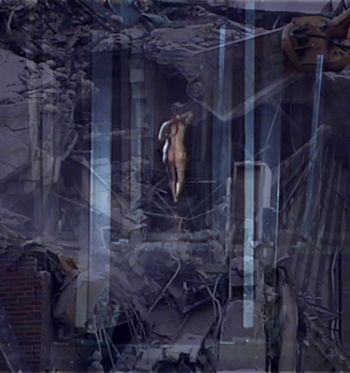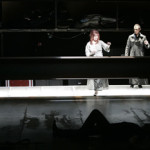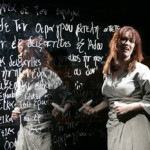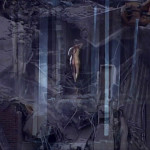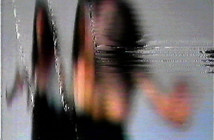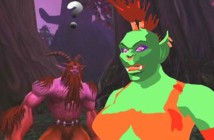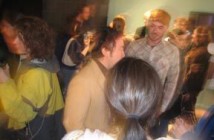A year ago, American Repertory Theater director, Robert Woodruff, approached Boston-based video artist Denise Marika about a possible collaboration on an unwritten project by Highway Ulysses playwright Rinde Eckert. Marika, an artist who usually creates her work alone, and whose subject matter is typically herself, along with maybe a family member, agreed to participate in the most collaborative art form ever: a stage play.
“It is an encyclopedic way of working…I yearn for collaboration” states Marika of the experience, “I’m used to having complete control, but this was similar to teaching.”
Drawing from previous work as well as creating new imagery, Marika and the A.R.T. team collaborated on what became Orpheus X, a play based on the Greek myth of Orpheus and Eurydice.
Orpheus X is about sensuality, emotionality, chaos and relationships. Eurydice is a poet hit by a taxicab in New York City. The passenger of the cab, Orpheus, is a famous rock star who becomes emotionally damaged by the accident. The 90 minute play revolves around the relationship, or the lack there of, between Orpheus and Eurydice. In the end, Orpheus—who, given instructions by his manager—goes to Hades and brings his ideal of Eurydice back.
“Unlike the myth, Orpheus does not know Eurydice. It is more about how we construct ideas about each other.” Marika states, “The questions are universal and timeless. By bringing Eurydice into a different role, it expands where the myth can go, and how it can relate to life.” Marika says of the adaptation. “ In this version, we did not want to make Eurydice the victim. We did not want her to go back willingly.”
If you have seen Marika’s video sculptures, you will understand why Woodruff approached her to work on this project. Simple and repetitive--yet clear and significant—Marika’s videos reflect ancient mythology and history. Her images stretch the boundaries and themes of classical and mythological art while dealing with human endurance, and explore human relations through gesture.
George Fifield, Curator of New Media at The DeCordova Museum, says of her work: “Denise takes little moments in time, and through performance and repetition expands them into mythical importance.”
Her work has been shown at the Museum of Modern Art, Mass MoCA, The Gardner Museum, The DeCordova Museum, and The Institute of Contemporary Art in Boston.
“I wanted to put eight pieces [of video]in conversation with each other” states Marika.
The cast of Orpheus X consists of three actors, three screens, and eight different video projections. This could have led to complete sensory overload, but the videos speak to and with the actors, adding to the chaotic nature of the piece and to the relationship between Orpheus and Eurydice.
The video is projected onto the floor as well as two huge I-beams, one vertical in the middle of the stage and one horizontal near the back. Organic, physical, sensual, and stunning, Marika’s video help bridge the gap between the “living” world of Orpheus, and Eurydice’s Hades, while the I beams that they are projected upon create a barrier between the two.
Images of blood, honey, and water help set the mood and tell the story of Orpheus and Eurydice that is not spoken. “As he wrote, (Eckhart) would send me pages, and I would glean imagery from them” states Marika.
Through this collaboration, Marika was able to channel images and themes from over two decades of work, and was given the chance to present them in a new light. “I wanted to bring the imagery that I felt the strongest about, into another context.”
Unearthed (2001), for example, was a video projection shown high on a wall at the Worcester Art Museum, in which Marika is crouched, with her back to the audience, throwing wet red clay on the wall, and then proceeding to furiously scrape it away. This piece was reborn in Orpheus X in the opening sequence of the play, in which you see Eurydice furiously sketching with chalk underneath the seats. This scene is then projected onto one of the three screens to be viewed as the audience walks in. The difference between the two pieces is the camera angle. In Unearthed, one watches the action from behind, while in Orpheus X, we view the action through the surface being written on. Similarly, Marika uses the previously shot footage of the destruction of a building from Detritus (2004), superimposing it on new footage of the characters in the play.
The recycling of these themes works best in the video used in the climax of the piece. Marika directly references an early work, Battle (1993-1994), a piece first exhibited at the Institute of Contemporary Art, of a man and a woman wrestling back and forth projected on the narrow surface of a vertical I-beam. “The imagery for the battle sequence was derived from the Battle pieces, but the gestures were new,” states Marika.
The collaborative nature of the piece has forced Marika to look at the differences between performance art, video art, and acting. Historically, there is a strong connection between performance and video art, but the link between performance art, video, and theater is fairly weak. In performance art, the artist is physically doing the action while confronting the viewer, whereas theater is role-playing. Even the stage is artifice. “These are the I-beams of my dreams!” stated an enthusiastic Marika. Having worked with real I-beams in Battle (1993-4) and Ash (2004), Marika was impressed that the A.R.T. was able to “fake it” and create stage prop I-beams, bigger and better than any she had ever seen. Considering the fact that the subject in most of Marika’s performances is her own body, trying to get the desired effect from another person’s performance expanded the way she works as a video artist. “I approached shooting more as a director than a performance artist.” Marika says of creating the videos, “I asked myself what was it that I wanted to get from them.”
Links:
The American Repertory Theatre
"ORPHEUS X" is playing at A.R.T.'s Zero Arrow Theatre from March 25 through April 23, 2006.
All images are courtesy of the American Repertory Theatre and by T. Charles Erickson.

